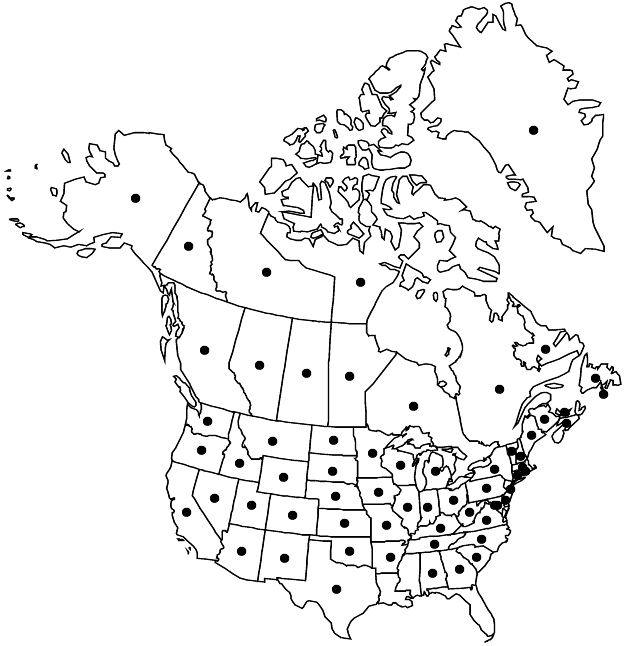Potentilla norvegica
Sp. Pl. 1: 499. 1753.
Stems ascending to erect, (0.5–)2–5(–9) dm, hairs at base ± stiff, tubercle-based, glands absent or sparse, inconspicuous. Leaves ternate, rarely palmate, 3–15(–20) cm; petiole 1–6(–10) cm, long hairs sparse to abundant, spreading to ascending, 1–2.5(–3) mm, usually ± stiff, ± crisped hairs absent or sparse to common, glands absent or sparse, inconspicuous; leaflets 3(–5), at tip of leaf axis, separate to ± overlapping, largest ones broadly oblanceolate or elliptic to obovate, 1–6(–10) × 0.7–4(–5) cm, distal (1/2–)2/3–3/4+ of margin usually ± evenly incised 1/4–1/3 to midvein, teeth (3–)4–8(–15) per side, surfaces sparsely to moderately hairy, sometimes glabrate or abundantly hairy, glands mostly absent. Inflorescences 5–40+-flowered. Pedicels (0.2–)0.5–2.5(–3) cm. Flowers: epicalyx bractlets ± elliptic to narrowly ovate, (3–)4–8(–13) × 1.5–3(–5) mm; hypanthium 4–7 mm diam.; sepals 5–8 mm, apex acute to obtuse; petals yellow, broadly obovate, (2–)3–5 × 2–4 mm; stamens 15 or 20, filaments 0.7–2 mm, anthers 0.3–0.5 mm; carpels 60–150, styles 0.7–0.8 mm. Achenes tan to brown, 0.8–1.3 mm, usually strongly rugose, without a corky protuberance. 2n = 42, 56, 63, 70.
Phenology: Flowering summer.
Habitat: Moist meadows, stream banks, lakeshores, roadsides, grasslands, hardwood and conifer woodlands, tundra
Elevation: 300–2700 m
Distribution

Greenland, St. Pierre and Miquelon, Alta., B.C., Man., N.B., Nfld. and Labr., N.W.T., N.S., Nunavut, Ont., P.E.I., Que., Sask., Yukon, Ala., Alaska, Ariz., Ark., Calif., Colo., Conn., Del., D.C., Ga., Idaho, Ill., Ind., Iowa, Kans., Ky., Maine, Md., Mass., Mich., Minn., Mo., Mont., Nebr., Nev., N.H., N.J., N.Mex., N.Y., N.C., N.Dak., Ohio, Okla., Oreg., Pa., R.I., S.C., S.Dak., Tenn., Tex., Utah, Vt., Va., Wash., W.Va., Wis., Wyo., Mexico, Central America, Eurasia, introduced in South America, Pacific Islands (New Zealand).
Discussion
Potentilla norvegica is considered native in both North America and Eurasia, with the American race occasionally recognized as subsp. hirsuta for the stiff hairs on the stems, petioles, and pedicels of most plants in the flora area. This feature and other purported differences between the two races, in addition to being relatively subtle and inconstant, can be found in both America and Eurasia, though undoubtedly at least in part as introductions. Some populations in eastern Canada with glabrous stems have been distinguished as var. labradorica (for example, M. L. Fernald 1950), but such plants typically are intermixed with hairy individuals. The Löves (Á Löve 1954; Á Löve and D. Löve 1966) have argued that all three variants should be treated as distinct species due to chromosomal differences (hirsuta 2n = 56; labradorica 2n = 42; norvegica in the narrow sense 2n = 70) and obligate apomixis. Further research is needed to determine the taxonomic validity and rank of these expressions. If treated as species, P. flexuosa antedates P. labradorica (as noted by J. Soják 1969), while P. monspeliensis, although commonly used for the American race, is based on a European type (as summarized by A. Kurtto et al. in J. Jalas et al. 1972+, vol. 13).
An even greater challenge is determining native versus introduced ranges, especially given the likelihood that both native and Eurasian populations are widespread in North America. Achenes are produced prolifically and easily dispersed, to the extent that Potentilla norvegica is a contaminant in clover and hay fields and considered a weed at least in Canada (P. A. Werner and J. D. Soule 1976).
Selected References
None.